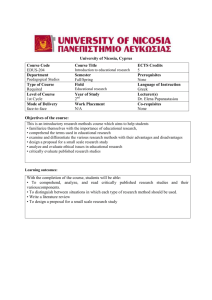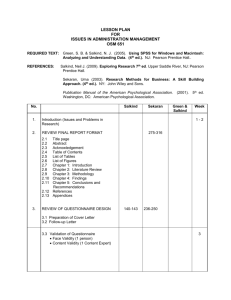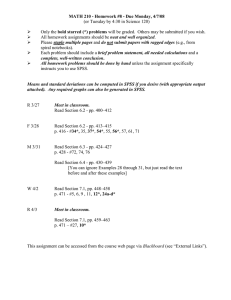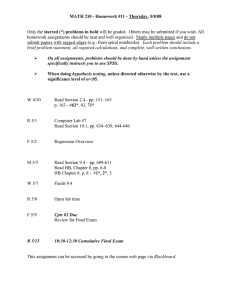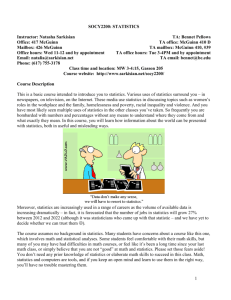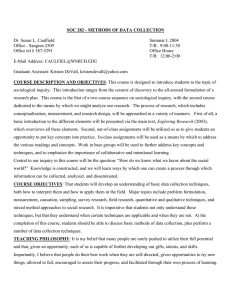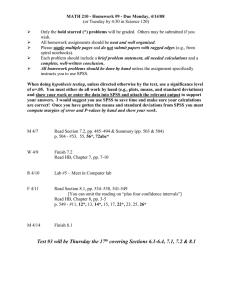JS 203: Seminar in Justice Research Methods Course Syllabus Spring 2009
advertisement
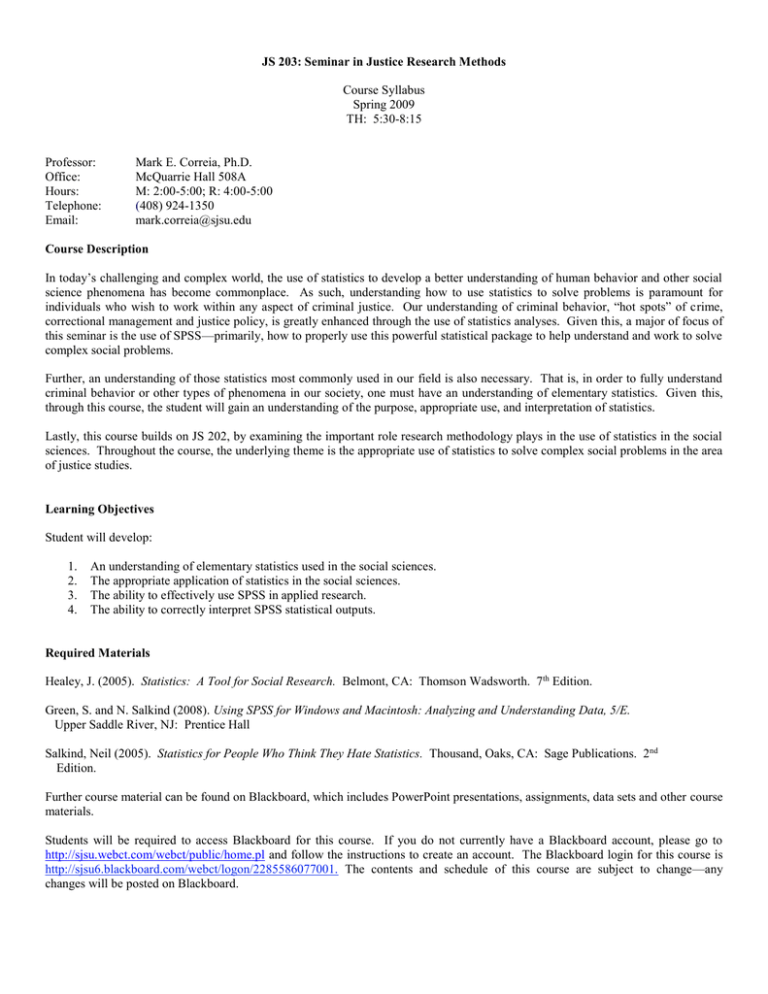
JS 203: Seminar in Justice Research Methods Course Syllabus Spring 2009 TH: 5:30-8:15 Professor: Office: Hours: Telephone: Email: Mark E. Correia, Ph.D. McQuarrie Hall 508A M: 2:00-5:00; R: 4:00-5:00 (408) 924-1350 mark.correia@sjsu.edu Course Description In today’s challenging and complex world, the use of statistics to develop a better understanding of human behavior and other social science phenomena has become commonplace. As such, understanding how to use statistics to solve problems is paramount for individuals who wish to work within any aspect of criminal justice. Our understanding of criminal behavior, “hot spots” of crime, correctional management and justice policy, is greatly enhanced through the use of statistics analyses. Given this, a major of focus of this seminar is the use of SPSS—primarily, how to properly use this powerful statistical package to help understand and work to solve complex social problems. Further, an understanding of those statistics most commonly used in our field is also necessary. That is, in order to fully understand criminal behavior or other types of phenomena in our society, one must have an understanding of elementary statistics. Given this, through this course, the student will gain an understanding of the purpose, appropriate use, and interpretation of statistics. Lastly, this course builds on JS 202, by examining the important role research methodology plays in the use of statistics in the social sciences. Throughout the course, the underlying theme is the appropriate use of statistics to solve complex social problems in the area of justice studies. Learning Objectives Student will develop: 1. 2. 3. 4. An understanding of elementary statistics used in the social sciences. The appropriate application of statistics in the social sciences. The ability to effectively use SPSS in applied research. The ability to correctly interpret SPSS statistical outputs. Required Materials Healey, J. (2005). Statistics: A Tool for Social Research. Belmont, CA: Thomson Wadsworth. 7th Edition. Green, S. and N. Salkind (2008). Using SPSS for Windows and Macintosh: Analyzing and Understanding Data, 5/E. Upper Saddle River, NJ: Prentice Hall Salkind, Neil (2005). Statistics for People Who Think They Hate Statistics. Thousand, Oaks, CA: Sage Publications. 2nd Edition. Further course material can be found on Blackboard, which includes PowerPoint presentations, assignments, data sets and other course materials. Students will be required to access Blackboard for this course. If you do not currently have a Blackboard account, please go to http://sjsu.webct.com/webct/public/home.pl and follow the instructions to create an account. The Blackboard login for this course is http://sjsu6.blackboard.com/webct/logon/2285586077001. The contents and schedule of this course are subject to change—any changes will be posted on Blackboard. Course Requirements Participation: While attendance is not required (you can’t participate if you are not here), it is assumed that students are prepared and willing to answer course-related questions when called upon and, when appropriate, to take part in class discussion. It is strongly suggested that you attend every class, as learning statistics and SPSS is a cumulative process. Readings and PowerPoint Presentations: Students should complete the readings prior to the date by which they appear on the syllabus. Many of the lectures are accompanied by a PowerPoint presentation that can be found on Blackboard. I strongly encourage students to download these and bring them to class. Please note, the PowerPoint presentations are not a substitution for attending class, they should be used to assist your work in class. Assignments (25% of final grade): Application equals learning. Therefore, there will be seven (7) assignments distributed throughout the course. The date of distribution and due date is specified on the syllabus. Students are strongly encouraged to email assignments on the due date or turn them in at the beginning of class. Any datasets collected through JS 202, may be used in this course and need to be provided to the professor prior to the second class meeting. Students may work with one another on the assignments, but are expected to turn in all of their own work associated with the assignment (i.e., SPSS outputs, mathematical computations, etc.). Late assignments will not be accepted. While assignments cannot be resubmitted, I encourage students to work with the professor regarding areas found to be difficult. Midterm Exam (25% of final grade): There will be a midterm exam distributed on March 5 th and is due March 12th. Article Reviews (15% of final grade): To assist in understanding statistics, we will read academic research articles that utilize the statistics under discussion. Students will be required to complete and turn in four (4) article reviews throughout the course, with one (1) from each of the four (4) sections. Articles must be published in academic journals in the area of justice studies. Format for the article reviews is attached at the end of the syllabus. I will drop the lowest article review grade if all reviews are turned in. Final Project (35% of final grade): This project will be distributed on April 23rd and is designed to measure the student’s competence in all areas discussed throughout the course. The project is comprehensive, drawing upon everything covered throughout the course. This project is due no later than May 18th and is time consuming—on average, it has taken students about 45 hours to complete, so please schedule your time accordingly. Email: I will accept assignments via email according to the following protocol. Assignments are due no later than 11:59pm on the due date. Deviations from this protocol will not be accepted and your email will be returned to you: 1. 2. 3. 4. 5. Subject Line: This line will contain the student’s name, course and the assignment number. For example, Mark Correia, JS 203: Assignment #1. Format: All papers sent electronically must be saved in .doc or .rtf. I will not accept papers saved in .wps, .wpd or pasted into an email. If you use Wordperfect, Microsoft Works or Office 2007, you will need to save your document as .doc or .rtf. Email Address: mark.correia@sjsu.edu Confirmation: I will send out a confirmation receipt for those emails with assignments that I have received within 48hrs. If you do not receive a confirmation, your assignment was not received. Responsibility: It is the student’s responsibility to make sure that the assignment is properly attached to the email. If the assignment is not attached and received by the due date, the assignment will be considered late. General email communication: Whereas email communication has become the primary method of communication, I will do my best to respond in a timely manner. I will respond within 24 hours between M-F and respond to any emails received during the weekend (Saturday and Sunday) on the following Monday. Course Outline This course consists primarily of lecture and computer lab work on Thursdays. I have listed my email address and office hours for your convenience. At all times, I will be available via email. If you cannot make my office hours, nor have access to email, please set up an appointment. While I may be in my office at other times, I may not be available to meet. WEEK #1 January 22: Course introduction and syllabus review Introduction to Blackboard and other Course Materials Statistics for the Social Sciences: Introduction Required Reading: Salkind, Chapt. 1 Healy, Chapt. 1 DESCRIPTIVE STATISTICS WEEK #2 January 29: Descriptive Statistics: Central Tendency Required Reading: Salkind, Chapt. 2 Healy, Chapts. 2, 3 Break Introduction to SPSS Required Reading: Green and Salkind, Unit 1 (Lessons 1-4) SPSS: Data Coding, Data Entry and Frequency Analysis Required Reading: Green and Salkind, Unit 2 (Lessons 5-11) Statistics Assignment #1 Distributed WEEK #3 February 5: Descriptive Statistics: Measures of Dispersion Required Reading: Healey, Chapt. 4 Salkind, Chapt. 3 Reliability and Validity Required Reading: Salkind, Chapt. 6 Break SPSS: Selecting Cases Required Reading: Green and Salkind, Unit 3 (Lesson 12) SPSS: Recoding and Computing Measures Required Reading: Green and Salkind, Unit 4 (Lesson 13) SPSS: Reliability Analysis Required Reading: Green and Salkind, Unit 9 (Lessons 37 and 38) SPSS: Measures of Central Tendency Required Reading: Green and Salkind, Unit 5 (Lesson 20) Statistics Assignment #1 Due; Statistics Assignment #2 Distributed WEEK #4 February 12: The Normal Curve and Probability Required Reading: Healey, Chapt. 5 Salkind, Chapt. 8 Break SPSS: Measures of Variability Required Reading: Green and Salkind, Unit 5 (Lesson 20) Statistics Assignment #2 Due; Statistics Assignment #3 Distributed Article Review Due INFERENTIAL STATISTICS WEEK #5 February 19: Hypothesis Testing: One and Two-Sample Cases Required Reading: Healy, Chapts. 8, 9 Salkind, Chapts. 10, 11 The Significance of Significance Required Reading: Salkind, Chapt. 9 Break SPSS: Hypothesis Testing Required Reading: Green and Salkind, Unit 6 (Lessons 22-24) Statistics Assignment #3 Due; Statistics Assignment #4 Distributed WEEK #6 February 26: Hypothesis Testing: Analysis of Variance (ANOVA) Required Reading: Healy, Chapt. 10 Salkind, Chapt. 12 Break SPSS: Hypothesis Testing Required Reading: Green and Salkind, Unit 7 (Lessons 25-28) Statistics Assignment #4 Due; Statistics Assignment #5 Distributed WEEK #7 March 5: Hypothesis Testing: Chi Square Required Reading: Salkind, Chapt. 16 Healey, Chapt. 11 Break SPSS: Contingency Tables Required Reading: Green and Salkind, Unit 10 (Lessons 40 and 41) Statistics Assignment #5 Due; Statistics Assignment #6 Distributed Article Review Due Midterm Exam Distributed BIVARIATE MEASURES OF ASSOCIATION WEEK #8 March 12: No Class: ACJS Conference in Boston Midterm Exam Due WEEK #9 March 19: Correlations: Describing Relationships Required Reading: Salkind, Chapts. 5, 14 Healey, Chapt. 15 Break SPSS: Correlations Required Reading: Green and Salkind, Unit 8 (Lessons 31 and 32) Statistics Assignment #6 Due Article Review Due WEEK #10 March 26: No Class: Spring Break MULTIVARIATE TECHNIQUES WEEK #11 April 2: Linear Regression: Simple and Multiple Required Reading: Salkind, Chapt. 15 Healey, Chapts. 16, 17 Break SPSS: Linear Regression Required Reading: Green and Salkind, Unit 10 (Lessons 33 and 34) Statistics Assignment #7 Distributed WEEK #12 April 9: Linear Regression: Cont. Required Reading: Salkind, Chapt. 15 Healey, Chapts. 16, 17 Break SPSS: Linear Regression Required Reading: Green and Salkind, Unit 8 (Lessons 33 and 34) WEEK #13 April 16: Logistic Regression Required Reading: Posted on Blackboard Break SPSS: Linear Regression Required Reading: None Statistics Assignment #7 Due WEEK #14 April 23: Hierarchical Linear Modeling Techniques Required Reading: Posted on Blackboard Break SPSS: Hierarchical Linear Modeling Techniques Required Reading: None Article Review Due Final Project Distributed WEEK #15 April 30: Work on Final Project Week #16 May 7: Work on Final Project Week #17 May 21: Final Project Due no later than 5:30 Syllabus Addendum Grading: In order to receive a grade for this course, all course requirements must be completed. Failure to complete any of them may result in a failing grade for the course. Paper and course grades may be disputed at the instructor’s convenience (or during office hours). It is important to note, however, that upon review, the instructor reserves the right to increase as well as decrease the grade in question. Late assignments and papers will not be accepted nor any extra credit provided. Academic Dishonesty: The “I got caught cheating” policy for this class is swift, severe, and certain: that is, if you cheat, chances are very good that you will be caught and punished with a failing grade for the product and possibly the course. In addition, plagiarism is absolutely unacceptable. If you are unsure what constitutes plagiarism, please contact the professor—while many students are ignorant of this offense, ignorance is not an excuse. I have several speeding tickets that prove this point! Academic Integrity: Academic integrity is essential to the mission of San José State University. As such, students are expected to perform their own work (except when collaboration is expressly permitted by the course instructor) without the use of any outside resources. Students are not permitted to use old tests, quizzes when preparing for exams, nor may they consult with students who have already taken the exam. When practiced, academic integrity ensures that all students are fairly graded. Violations to the Academic Integrity Policy undermine the educational process and will not be tolerated. It also demonstrates a lack of respect for oneself, fellow students and the course instructor and can ruin the university’s reputation and the value of the degrees it offers. We all share the obligation to maintain an environment that practices academic integrity. Violators of the Academic Integrity Policy will be subject to failing this course and being reported to the Office of Student Conduct & Ethical Development for disciplinary action that could result in suspension or expulsion from San José State University. The policy on academic integrity can be found at: http://sa.sjsu.edu/student_conduct To better understand plagiarism and to aid you in making sure that you are not plagiarizing, please see me and/or visit: http://tutorials.sjlibrary.org/plagiarism/index.htm Course Add/Drop Statement: Instructors are permitted to drop students who fail to attend the first scheduled class meeting and who fail to inform the instructor prior to the second class meeting of the reason for any absence and their intention to continue in the class. Some instructors will drop students who do not meet the stated course prerequisites. However, instructors are not required to drop a student from their course. It is the student’s responsibility to make sure classes are dropped. You, the student, are responsible for understanding the policies and procedures about add/drops, academic renewal, withdrawal, etc. found at: http://sa.sjsu.edu/student_conduct ADA: “If you need course adaptations or accommodations because of a disability, or if you need special arrangements in case the building must be evacuated, please make an appointment with me as soon as possible, or see me during office hours. Presidential Directive 97-03 requires that students with disabilities register with DRC to establish a record of their disability.” Electronic Devices: Please turn off all cell phones, pages, PDA’s or any other electronic device that “makes noise”. While I commend those of you who have mastered text messaging, the use of these devices during class is disruptive and will not be tolerated. If I see you text messaging, I will ask you to leave the room. Classroom Etiquette: Class motto: “Treat others as you think they would like to be treated”. Yes, this is a spin on the ever popular, but not so empathetic phrase. This is a time to open your minds to new ideas, to explore new concepts, so please take advantage of this opportunity. Further, please be respectful of others and show them common courtesy. I firmly believe that the learning process is enriched by discussion, but damaged by arguments. Respect and professionalism are the guiding principles of this class. Tardiness will not be tolerated, if you are late, do not disturb class— wait until break to enter the classroom. Written Work: I understand that many of our students have very busy lives, filled with work and family obligations. I understand that “school work” is difficult to fit in to an already full schedule. With this said, I do expect quality work from everyone. Complete all work as though it is your best work ever and be proud of the work you complete for this course. As a side note: I am well aware of the websites that offer papers to students and have software that allows me to compare papers I receive to the thousands of databases of papers that exist. Trust me, it is not worth your effort, chances are, I will find out. All papers that are turned in to this class will be submitted to turnitin.com. Please see the course website for additional information. +/- Grading: This course will be using the +/- system on final grades based on the following percentages. No curve will be instituted: 95-100: 87-89: 80-83: 74-76: 0-69 A B+ BC D 90-94: 84-86: 77-79: 70-73: AB C+ C- Article Critique Guidelines JS 203 Please address (to some degree) each of the questions listed below. It is important to note that an article critique is not simply a review of the work, but a critical analysis of the methods and statistical techniques employed in the study. The purpose of the critique it so to assess the appropriateness of the statistical techniques employed (see questions below). At times, you may find it useful to use additional works to strengthen your critique. The critique should be no longer than 6 pages and must abide by APA guidelines. In your critique, please address the following questions to the appropriate degree: 1. What is the basic research question or problem? Try to state it in just one sentence. Were any hypotheses stated? 2. What were the independent and dependent variables in the hypothesis or hypotheses? Continuous or categorical? Did these variables reflect the theoretical concepts as intended? What direction of association was hypothesized? 3. What type of data was used? Is this type of data appropriate for the population and research question? What other types of data might have been used? 4. Were the instruments, the measures of the variables, valid and reliable? How did the author establish this? Could any more have been done in the study to establish measurement reliability and validity? 5. What type of sample was selected? Did the authors think the sample was generally representative of the population from which it was drawn? Do you? How would you evaluate the likely generalizability of the findings to other populations? 6. What statistical tests were used? Were these appropriate to address the research question? Were the statistical tests used appropriately? Were confidence intervals reported? Were effect sizes reported? How clearly were statistical and/or qualitative data presented and discussed? Were the results substantively important? 7. Summarize the author’s conclusions. Trace each conclusion back to the specific evidence supporting the conclusions. Did the authors adequately represent the findings in the discussion and or conclusions sections? Were conclusions grounded in the findings? Are any other interpretations possible? Is it linked to the evidence or not? 8. What additional research questions and hypotheses are suggested by the study’s results? What light did the study shed on the theoretical framework used? On social policy questions?
